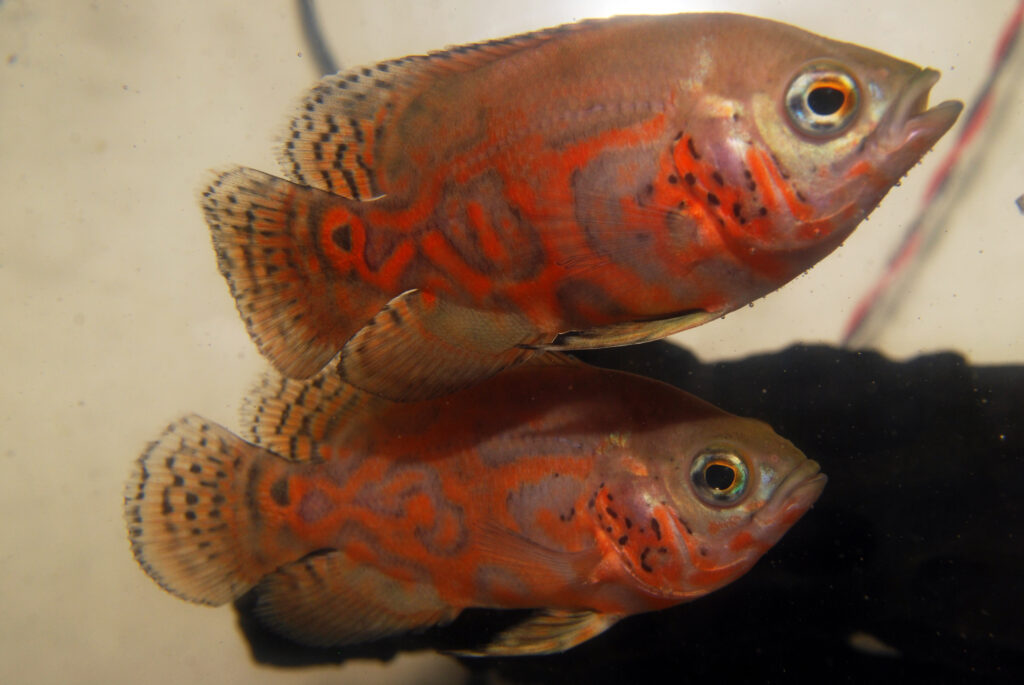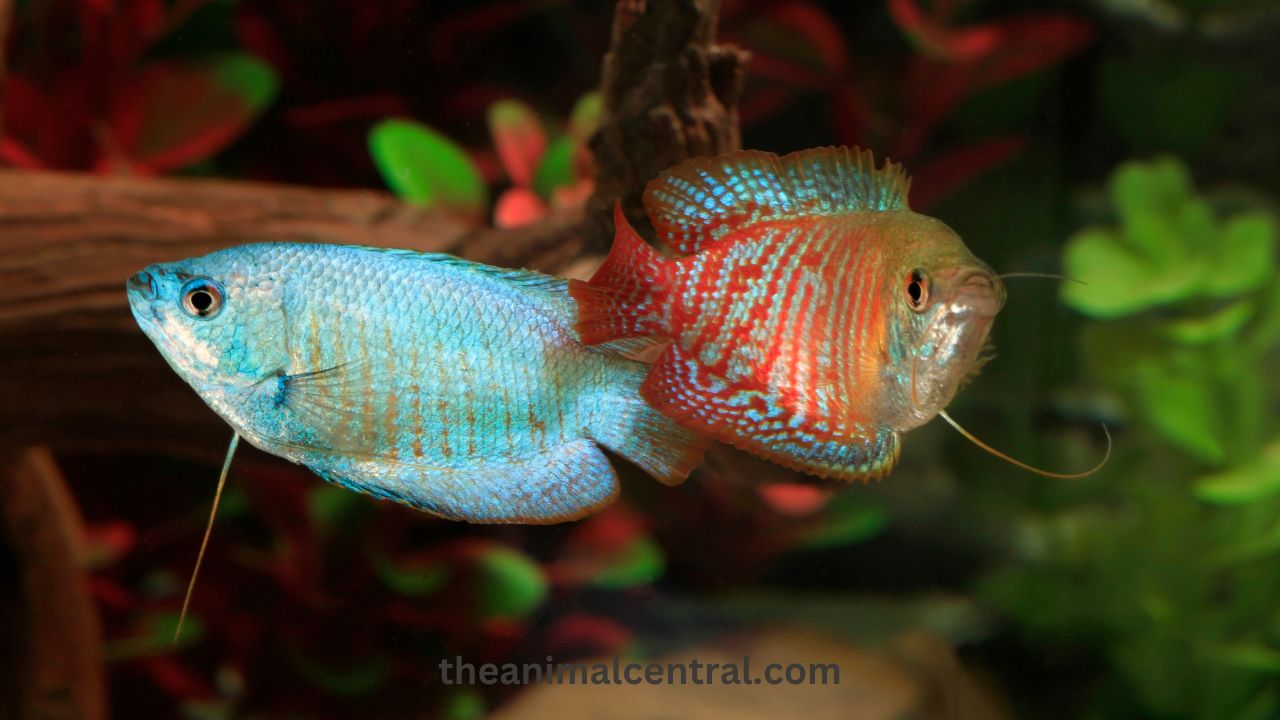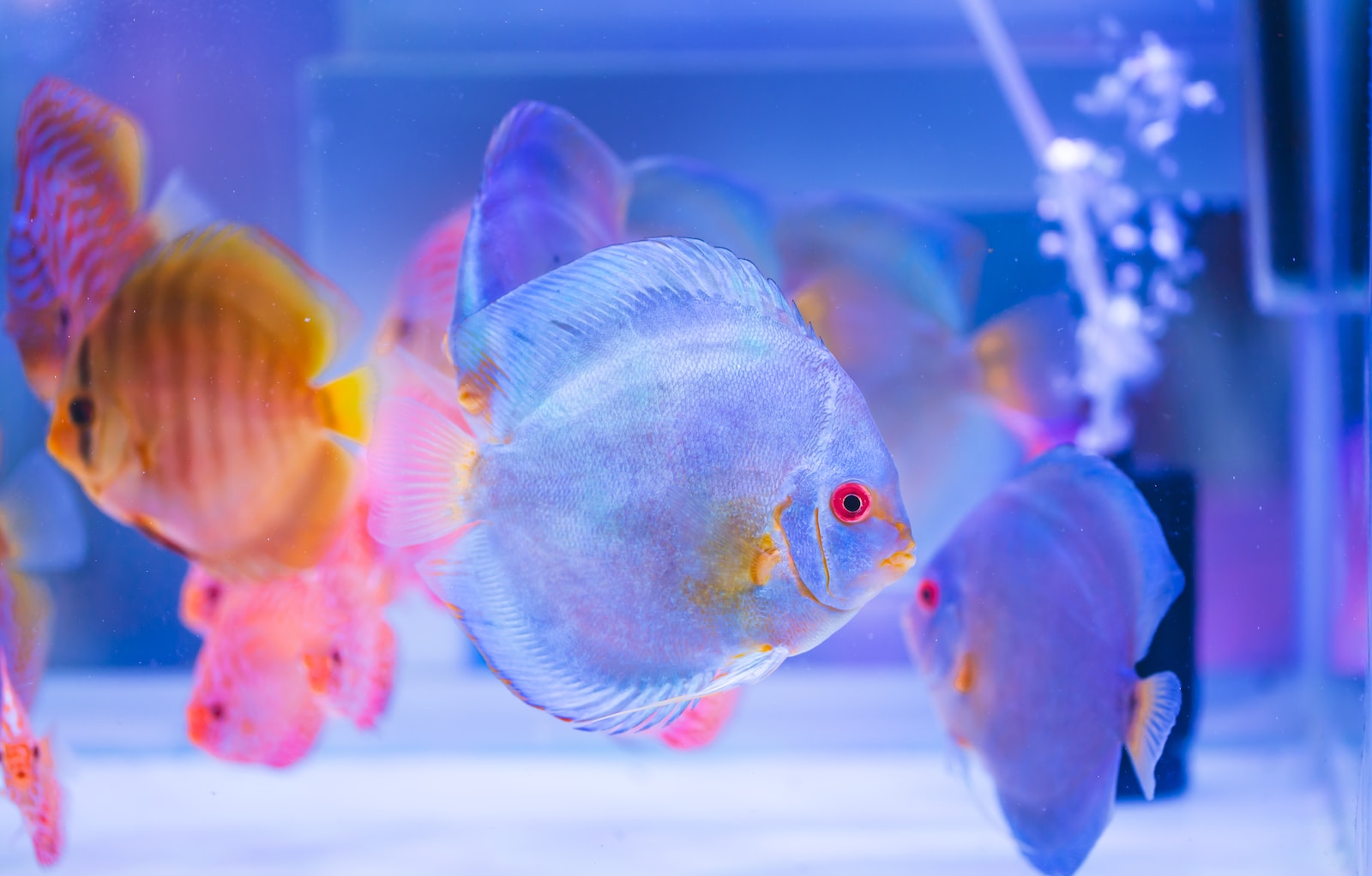Did you know Oscar fish can lay up to 3,000 eggs at once? This fact shows how these cichlids can breed. Breeding oscar fish at home is rewarding but needs careful planning.
Oscar cichlids, also known as Astronotus ocellatus, are smart fish that can grow up to 15 inches. Their size and unique personalities make them popular. To breed them at home, you must understand their biology and create the right environment.
These cichlids reach sexual maturity around 14 months. But, some may not breed until they’re 2 or 3 years old. To breed oscar fish, you need a big tank of at least 55 gallons for a pair of 6-inch fish. Success in breeding oscar cichlids depends on the right water conditions, a balanced diet, and a stress-free environment.
Table of Contents
Key Takeaways
- Oscar fish can lay up to 3,000 eggs in one spawning
- Sexual maturity is reached at 14 months, but breeding may start later
- A minimum 55-gallon tank is needed for breeding
- Proper water conditions and diet are essential for success
- Breeding oscar fish at home requires patience and careful observation
Understanding Oscar Fish Biology and Sexual Maturity
To care for Oscar fish, you need to know about their biology and behavior. These fish can grow up to 30 cm long and weigh 1.5 kg. With the right care, they can live for 10 to 15 years, which is a big commitment for aquarium lovers.
Physical Characteristics of Adult Oscars
Oscar fish come in many colors. Tiger Oscars have bold black stripes with bright orange, red, and yellow. Albino Oscars have a creamy white body and bright red eyes. Red Oscars are bright red, while Wild Type Oscars have shades of green, brown, and black.
Natural Behavior and Intelligence
Oscar fish behavior is complex. They are smart and can recognize their owners. They show interesting behaviors like gill flaring and fin spreading. During breeding, they even lock jaws, showing their unique way of communicating.
Sexual Dimorphism and Gender Identification
Knowing when Oscar fish are ready to breed is key. They usually reach sexual maturity at about 14 months. Males grow faster than females. It’s hard to tell the sex, but looking at their breeding tubes is the best way. Females have short, stubby tubes, while males have thin, curved ones.
| Characteristic | Male Oscar | Female Oscar |
|---|---|---|
| Growth Rate | Faster | Slower |
| Breeding Tube | Thin, curved | Short, stubby |
| Behavior during Breeding | More aggressive | Less aggressive |
Knowing about Oscar fish biology is key to caring for them and breeding them successfully in captivity.
Essential Tank Requirements for Breeding Setup
Creating the perfect oscar fish tank for breeding needs careful planning. I’ll show you the key elements for an ideal environment. This will help your oscar fish thrive and reproduce well.
Optimal Tank Size and Configuration
Tank size is important for oscar fish breeding. A 55-gallon tank is the minimum, but a 75-gallon or larger is better. This extra space helps the breeding pair have their own territories and reduces stress.
To fit two adult oscars, aim for a tank that’s 5-6 feet long. It should hold at least 90-100 gallons.
Water Parameters and Filtration Systems
Keeping the water conditions right is key for oscar fish tanks. The temperature should be between 74-81°F. During breeding season, it should be a bit warmer, between 82-85°F.
The pH level should be between 6.5-7.5. A strong filtration system is needed to handle the waste of oscars. Use a mix of undergravel, canister, and hang-on-back filters for the best results.
Substrate and Decorations for Spawning
Use sand as the substrate to let oscars burrow naturally. Add large rocks or PVC pipes for hiding spots. A flat rock or slate piece is key for egg-laying.
These elements help create a comfortable space for breeding and caring for eggs. The right setup can greatly increase your breeding success.
| Tank Element | Recommendation |
|---|---|
| Minimum Tank Size | 55 gallons |
| Ideal Tank Size | 75-100 gallons |
| Temperature | 74-81°F (82-85°F for breeding) |
| pH Level | 6.5-7.5 |
| Substrate | Sand |
| Decorations | Large rocks, PVC pipes, flat slate |
Oscar Fish Breeding: Step-by-Step Process
The oscar fish breeding process is both fascinating and rewarding. To begin, you need mature adults, usually 12-18 months old. A 100-gallon tank is best for oscar fish spawning, giving them plenty of space.
To create the right environment, I keep the water temperature between 74°F to 81°F (23°C to 27°C). I also ensure a filter flow rate of at least 400 gallons per hour. These conditions help mimic their natural habitat and encourage breeding.
Next, I focus on nutrition. A diet rich in protein helps prepare the fish for spawning. As breeding time nears, I watch for signs like gill flaring, fin spreading, and rock cleaning. These behaviors show the oscar fish breeding process is starting.
The actual spawning lasts about three hours. During this time, the female lays eggs while the male fertilizes them. You can expect anywhere from 300 to 3,000 eggs, depending on the fish’s size.
| Breeding Factor | Optimal Condition |
|---|---|
| Tank Size | 100 gallons minimum |
| Water Temperature | 74°F to 81°F (23°C to 27°C) |
| Filter Flow Rate | 400 gallons per hour |
| Fish Age | 12-18 months |
| Spawning Duration | Approximately 3 hours |
How to Select an Oscar Breeding Pair?
When breeding Oscar fish, choosing compatible pairs is crucial to success. Unlike some species, Oscars often form natural pairs rather than being forced into breeding partnerships. To ensure compatibility, consider these steps:
-
Allow Natural Pairing: Start by housing a small group of juvenile Oscars (four to six) in a large tank. This allows them to grow together, which encourages natural pairing. Observing them will reveal any pair bonds that develop over time.
-
Check for Bonding Behaviors: When Oscars form a bond, you may notice them swimming side by side, defending each other, and establishing a territory. They often engage in gentle jaw-locking and fin-flaring as signs of courtship rather than aggression.
-
Monitor Compatibility: Once a pair is identified, relocate them to a separate tank if possible. A lack of aggression and mutual interest in a designated spawning site (often a flat rock or slate) are good indicators of a compatible pair ready for breeding.
-
Assess Health and Maturity: Select mature Oscars (typically 14 months or older) in good health, as this increases the chances of successful egg-laying and rearing.
Creating the Perfect Water Conditions
Keeping the right water conditions is key for oscar fish breeding success. The right water parameters can make a big difference. Let’s explore how to create the best environment for your oscar fish to breed and thrive.
Temperature Management
Oscars need warm water to breed. I keep the water between 74°F and 81°F (23°C-27°C). It’s vital to use a good heater and keep it safe from oscars, as they can be rough.
pH and Hardness Levels
For breeding, I keep the pH between 6 and 8. The water hardness should be 5-20 dH. These levels match their natural habitat in Central America.
Water Change Schedule
Regular water changes are a must. I change 25-50% of the water at least once a week. During breeding, I do it more often. This keeps nitrate levels low and ensures no ammonia or nitrites.
| Parameter | Ideal Range | Importance |
|---|---|---|
| Temperature | 74°F – 81°F (23°C-27°C) | Crucial for breeding behavior |
| pH | 6.0 – 8.0 | Affects egg development |
| Hardness | 5 – 20 dH | Influences overall health |
| Nitrates | <40 ppm | Prevents stress and illness |
| Ammonia/Nitrites | 0 ppm | Toxic if present |
By keeping these water parameters right, you’re setting up a great breeding environment. Remember, being consistent is important. Regular checks and adjustments will help your oscars be ready to spawn.
Nutrition and Diet for Breeding Pairs
A good diet is key for oscar fish to breed well. I’ve learned that a balanced diet helps with egg growth and keeps the breeding pair healthy.
Essential Nutrients for Breeding Success
I make sure my oscars eat a variety of foods. They get 70-90% of their food from high-quality pellets. The rest comes from protein-rich foods like shrimp and beef heart. Fruits and veggies add vitamins and minerals.
Live Food Options
Live foods make feeding time exciting and are good for them. I give bloodworms, mealworms, and crickets as treats. Sometimes, I add guppies or platies, which I raise myself, for extra nutrition.
Feeding Schedule and Portions
I’ve found a feeding plan that works for my breeding oscars. Here’s what they eat every day:
| Time | Food Type | Portion |
|---|---|---|
| Morning | High-quality pellets | Small handful |
| Afternoon | Live or frozen food | 4-5 pieces per fish |
| Evening | Vegetables or fruits | Small slice |
This schedule helps my oscars get the nutrients they need all day. It supports their breeding and keeps them healthy.
Identifying and Managing Breeding Behavior
Oscar fish breeding behavior is truly captivating. When they’re ready to mate, they show unique signs. These include tail slapping, side-by-side wagging, and vibrating. They even lock jaws, which might seem aggressive but is actually part of their courtship.
Before mating, oscars prepare a special site. They clean a flat area at the tank’s bottom for the female to lay her eggs. As they get closer to spawning, the female’s ovipositor and the male’s breeding tube change. These changes show that egg-laying is about to happen.
During breeding, oscars can become very territorial and aggressive. To handle this, I make sure they have lots of space and hiding spots. If aggression gets too high, I might remove other fish to keep everyone safe. It’s important to watch the tank closely during breeding.
| Breeding Behavior | Description | Management |
|---|---|---|
| Tail Slapping | Quick, forceful tail movements | Normal behavior, no intervention needed |
| Side-by-Side Wagging | Pair swims close together, wagging bodies | Ensure ample swimming space |
| Jaw Locking | Mouths grip each other briefly | Part of courtship, monitor for injuries |
| Site Cleaning | Pair cleans flat surface for eggs | Provide suitable spawning sites |
| Aggression | Territorial behavior towards other fish | Remove other fish if necessary |
Egg Laying and Fertilization Process
Oscar cichlid spawning is truly fascinating. These fish show unique behaviors during this time. Let’s look at the signs of successful spawning, how parents behave, and common problems.
Signs of Successful Spawning
When oscar fish are ready to spawn, they clean a flat surface carefully. The female lays her eggs in neat rows. These eggs are tiny, about 1mm in diameter, and look opaque white.
A successful spawn can have 300 to 3,000 eggs. This depends on the size of the fish.
Parent Fish Behavior During Spawning
The female passes over the chosen spot multiple times, laying eggs. The male follows, fertilizing the eggs. After laying, both parents guard the eggs fiercely.
They fan the eggs constantly to prevent smothering. This is key for the eggs to survive.
Common Spawning Problems
Oscar cichlids may face challenges during spawning. Fungal growth on unfertilized eggs is a common problem. If I see this, I remove affected eggs to protect the healthy ones.
Inexperienced parents might struggle to protect their eggs. This can lead to losing the first few spawns. Water quality is important to prevent bacterial and fungal infections in developing eggs.
| Spawning Issue | Possible Cause | Solution |
|---|---|---|
| Fungal growth on eggs | Poor water quality | Improve filtration, regular water changes |
| Low fertility rate | High water flow | Reduce water current during spawning |
| Eggs not fertilized | Inexperienced parents | Patience, allow multiple spawning attempts |
Caring for Oscar Fish Eggs
Oscar fish egg care is key for successful breeding. Hatching oscar fish eggs needs careful attention and the right conditions. The process usually takes 2-3 days. During this time, the parents might eat eggs that are not fertilized or have fungus.
For artificial incubation, I remove the egg-covered surface and put it in a separate tank. It’s important to have gentle aeration to keep the eggs oxygenated. To stop infections, I use treatments like acriflavine or methylene blue.
When the eggs hatch, I change the water but don’t feed the fry yet. This is a critical time for the young oscar fish to survive. The female lays about 1000 eggs over a few days during spawning.
| Oscar Egg Care Facts | Details |
|---|---|
| Hatching time | 2-3 days |
| Number of eggs laid | Approximately 1000 |
| Hatching success rate | Higher in captivity than in the wild |
| Antimicrobial treatments | Acriflavine, methylene blue |
Unfertilized oscar eggs might get a fungus that looks like cotton wool. It’s vital to watch the eggs closely and remove any infected ones. This helps protect the healthy eggs. With the right care, hatching success can be high in captivity.
Raising Oscar Fish Fry

Raising baby oscars can be very rewarding for aquarium fans. Taking care of oscar fish fry needs careful attention and knowledge. I’ll show you how to help these tiny fish grow into strong adults.
First Feeding Stages
Oscar fry start swimming freely about 10 days after they hatch. They’re ready for their first food at this time. I feed them tiny foods like brine shrimp or fry food. It’s important to give them small meals often to help them grow fast.
Growth Monitoring
Oscar fish grow fast, often getting 1-2 inches bigger each month early on. I watch their growth closely and change their food as needed. When they get bigger, I start giving them bigger food to meet their needs.
Disease Prevention
Keeping the water clean is vital to stop diseases in oscar fish fry. I do regular water changes and check the water’s quality. The best temperature for raising baby oscars is between 75°F to 81°F. A pH between 6.5 and 7.5 also helps them stay healthy.
| Parameter | Ideal Range |
|---|---|
| Temperature | 75°F – 81°F |
| pH | 6.5 – 7.5 |
| Nitrates | <40 ppm |
By following these tips for oscar fish fry care, you can successfully raise baby oscars into healthy, colorful adults.
Common Breeding Challenges and Solutions
Breeding Oscar fish can be tricky. I’ve faced many oscar fish breeding problems over the years. One issue is egg eating by parents. To solve this, I separate eggs for artificial incubation. This keeps them safe from hungry parents.
Fungal infections are another concern. I use antifungal treatments to combat this oscar fish breeding problem. It’s important to catch and treat infections early.
Aggression between breeding pairs can disrupt the process. I provide adequate space and hiding spots to reduce tension. Sometimes, pairs need multiple spawning attempts before success. Patience is key in oscar fish breeding.
Here are some helpful oscar fish breeding tips:
- Maintain a tank size of at least 50 gallons
- Keep water temperature between 77-81°F
- Perform weekly water changes of 10-15%
- Feed a varied, nutrient-rich diet
- Choose fish at least two years old for breeding
Remember, female Oscars can lay up to 1000 eggs in batches. With proper care, you can increase the survival rate of these eggs in captivity. By addressing these common challenges, you’ll be well on your way to successful Oscar fish breeding.
Conclusion
In this guide, I’ve shared key tips for breeding oscar fish. These cichlids can grow up to 15 inches and live for 10-13 years. They need a lot of space, with a 75-gallon tank for one fish and 50 gallons for each more.
Breeding Oscars requires a lot of effort and patience. They can lay 1,000 to 3,000 eggs at a time. Natural mating is best for their health and more babies.
For 20 years, scientists watched 189 Oscar couples. They found that Oscars can start breeding before they’re a year old. They can keep breeding for up to 10 years.
The journey of breeding oscar fish is both tough and rewarding. By following this guide and creating the right environment, you can succeed. The fish keeping hobby is huge, with a global value over $1 billion. It’s the second most popular hobby after photography, bringing the underwater world to your home.
FAQ
At what age do Oscar fish reach sexual maturity?
What size tank do I need for breeding Oscar fish?
How can I tell the difference between male and female Oscars?
What water parameters are ideal for breeding Oscar fish?
What should I feed Oscar fish to encourage breeding?
How many eggs do Oscar fish typically lay?
How long does it take for Oscar fish eggs to hatch?
When do Oscar fish fry become free-swimming?
What should I feed newly hatched Oscar fish fry?
How fast do Oscar fish grow?
What are some common breeding challenges with Oscar fish?
Can Oscar fish be trained?
How often should I change the water in my Oscar breeding tank?
What substrate is best for Oscar fish breeding tanks?
Can I breed Oscars in a community tank?
How do I know if my Oscars are ready to spawn?
What do I do if the parents eat the eggs?
How long do Oscar parents care for their fry?
Can I raise Oscar fry with other types of cichlid fry?
| Organization Name | Website URL |
|---|
| American Cichlid Association (ACA) | cichlid.org |
| International Union for Conservation of Nature (IUCN) | iucn.org |
| World Wide Fund for Nature (WWF) | worldwildlife.org |
| Ornamental Fish International (OFI) | ofish.org |
| United Nations Food and Agriculture Organization (FAO) – Fisheries Division | fao.org |
| World Aquatic Veterinary Medical Association (WAVMA) | wavma.org |
| European Association of Zoos and Aquaria (EAZA) – Fish and Invertebrate TAG | eaza.net |
| International Union of Aquarium Professionals (IUAP) | iuap.org |
I am a passionate aquarist with over 30 years of hands-on experience in fishkeeping. My journey began at a young age, collecting fish from the wild and learning through experimentation. Specializing in tropical fish, I bring a deep understanding of the hobby to FishKeepingMadeSimple. The site provides honest, detailed reviews of essential products and accessories to help fellow enthusiasts create the best environments for their fish.








